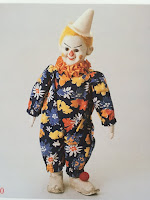Hot dog! Most readers are familiar with Steiff's beloved "Biggie" Beagle model. Here's an example of this fan favorite that really merits the name. Check out this life-sized Steiff Beagle and see what makes him so interesting from the collector's perspective.
This "Best of Show" beauty is Steiff's studio (or display size) Beagle. He stands 14 inches tall and 16 inches long (not including his tail) and 24 inches long including his tail. He is made from tan mohair and is head jointed. His head, body, and tail are elaborately hand-painted with delightful shades of black, grey, and brown, giving him wonderful definition. He has three black hand embroidered claws on each paw. His face comes to life with brown and black pupil eyes, a black hand embroidered nose and mouth, and floppy ears. He retains his original red buckled collar. This Beagle was produced in this size only from 1965 through 1966 as an exclusive for the upscale toy retailer FAO Schwarz.
 This regal Beagle stands and delivers with his great IDs. Like most Steiff items sold at FAO Schwarz during his era, this dog sports the company's red wooden "bell" tag. This features a golden bell and the words, "EST. 1862 TOYS FAO SCHWARZ." This old fashioned design is based on a bell carved in the Schwarz family's wooden dining room table. This piece of furniture was originally located in the family's Greenwich, CT home. The Beagle also has his raised script button, and fully legible yellow ear tag. It is numbered 1343,90, which corresponds to 1=standing, 3=mohair, 43=43 cm, 9=display animal or special edition, and 0=normal coloring.
This regal Beagle stands and delivers with his great IDs. Like most Steiff items sold at FAO Schwarz during his era, this dog sports the company's red wooden "bell" tag. This features a golden bell and the words, "EST. 1862 TOYS FAO SCHWARZ." This old fashioned design is based on a bell carved in the Schwarz family's wooden dining room table. This piece of furniture was originally located in the family's Greenwich, CT home. The Beagle also has his raised script button, and fully legible yellow ear tag. It is numbered 1343,90, which corresponds to 1=standing, 3=mohair, 43=43 cm, 9=display animal or special edition, and 0=normal coloring. Beagles were a very popular breed in the 1960's, most likely because they were the "Presidential Pets" of Lyndon B. Johnson. His Beagles, which included Him and Her, were truly the "First Dogs" of America - often accompanying the President on visits to heads of state, hanging out in the Oval Office, and swimming in the White House pool. These lucky dogs were even featured on the cover of Life Magazine in 1964. As such, FAO Schwarz picked up on this cultural trend to create a number of exclusive Beagles for their customers, including this display example under discussion here. Other FAO Schwarz exclusive Beagles included a 15 cm standing open mouthed Beagle (sort of a hybrid in design between Steiff's regular line sitting and standing Biggies) and and a family of Beagles in a basket, resting on a soft cushion.
And really, just how "big" is this special FAO Schwarz Biggie? Steiff Supermodel BooBoo the real-life pug, (reluctantly) shares the spotlight with him so you can see his scale firsthand.
Steiffgal hopes this discussion of this rare display size Steiff Beagle has made a big impression on you!
Have a question about one of your Steiff treasures? Let's talk! Click here to learn more.



















